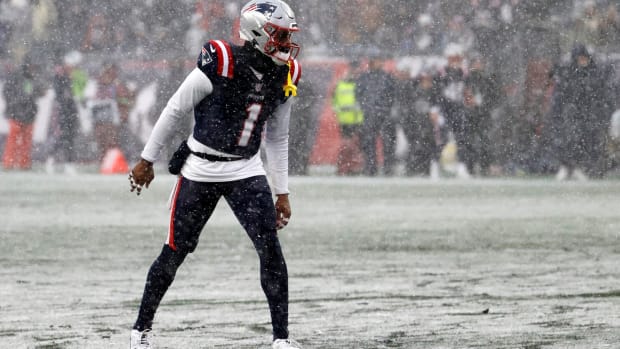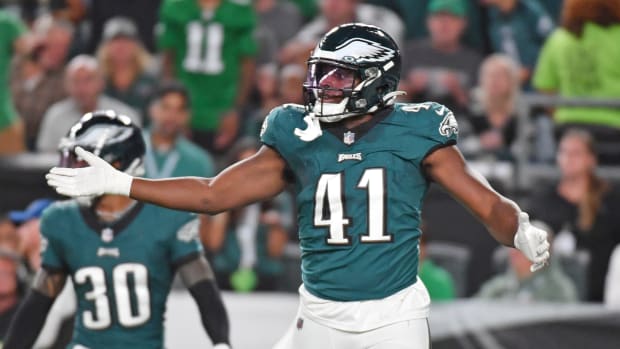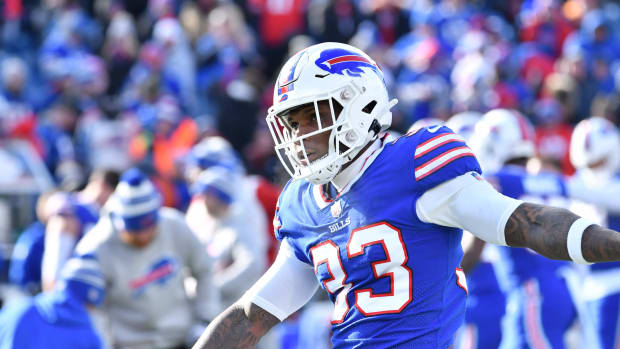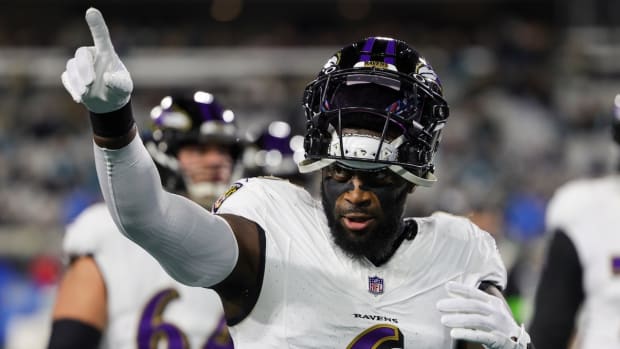The NFL's Hidden Talents: Best play-action quarterbacks
The NFL may have become more of a passing league over the last decade, but the threat of the run is still crucial to the success of most passing games, depending how efficiently the quarterback utilizes play-action. Faking the run and passing instead is one of the best ways to create matchup advantages and openings in coverage. No less an offensive mind than Bill Walsh relied heavily on play-action, even when his running game was an ancillary factor at best.
“The Play-pass is the one fundamentally sound football play that does everything possible to contradict the basic principles of defense,” Walsh wrote in 1997. “I truly believe it is the single best tool available to take advantage of a disciplined defense. By using the play-pass as an integral part of your offense you are trying to take advantage of a defensive team that is very anxious, very intense and very fired-up to play football. The play-pass is one of the best ways to cool all of that emotion and intensity down because the object of the play-pass is to get the defensive team to commit to a fake run and then throw behind them. Once you get the defensive team distracted and disoriented, they begin to think about options and, therefore, are susceptible to the running game.
• SI.com's NFL off-season report cards | KING: Off-season Power Rankings
Overpaid or underpaid? Taking stock of the quarterbacks in the $100M club
“In highly competitive football, it is very unlikely that you will be able to run the ball so effectively that you will not need to do anything else to move the football. There is no question that having the play-pass, as a part of your offensive arsenal, can allow you to get a key first down or big chunks of yardage.”
That's as true today as it was in Walsh's era, and the best play-action quarterbacks of the modern era are coveted in part for their ability to fool defenses into guessing wrong. Who are those quarterbacks? Based on Pro Football Focus's charting metrics and specific tape study, here are five field generals who wouldn't be where they are without the play-fake.
Andrew Luck, Colts
It's not exactly a news flash that Andrew Luck does a lot of things really, really well on the field, but more should be said about his ability to beat defenses with play-action. It's something he excelled at while he worked under Jim Harbaugh and David Shaw at Stanford, and when former Stanford offensive coordinator Pep Hamilton replaced Bruce Arians as Indy's coordinator in 2013, it made sense that Luck's play-action game would thrive. When Hamilton started working with Luck in 2011, Luck's rate of snaps using play-action flew up to 28% from 22% the year before. His touchdowns off play-action doubled from eight to 16.
Luck ran play-action on 16.8% of his passing attempts in his rookie season of 2012 under Arians, with six touchdowns and two interceptions. That kicked up to 19.5% in 2013, with four touchdowns and no interceptions. But last season, Hamilton took off the training wheels, and Luck became by far the league's best play-action quarterback. Including the postseason, Luck threw from play-action on 20.8% of his passing attempts (Alex Smith led the league at 31%, for context), with 13 touchdowns and one interception. Compare those totals to his 30 touchdowns and 19 picks on all other plays.
Yikes: Zac Stacy looks back on his infamous draft day tweet
And given the sub-optimal nature of the Indianapolis run game in 2014, Luck proved what coaches already know: You don't need a dominant ground game to put a defense on edge with play-action. Just the threat of the run is enough, even if that's all you have.
This 73-yard touchdown to T.Y. Hilton in Week 12 against the Jaguars was a direct result of a play-fake to Trent Richardson, perhaps the least effective running back in the NFL. Still, Jags cornerback Dwayne Gratz was caught looking for a brief moment, and that's all it took for Hilton to blow by him. When you have single-coverage responsibility on a guy with Hilton's ability to accelerate, it's best to focus on what's in front of you.
Against the Giants in Week 9, the Colts went a different route by flaring Richardson outside to the left. This took linebacker Devon Kennard out of the middle in New York's red zone defense and forced Mark Herzlich to move over. Unfortunately, Herzlich also completely bit on the fake to Ahmad Bradshaw, and tight end Dwayne Allen was about as open as any target in the end zone will ever be as a result for the two-yard touchdown. This play-fake earns bonus points for the two-halfback backfield, by the way.
What could make the Colts' play-action game even tougher to deal with? How about a running back who faced an abnormally high number of stacked defenses throughout his career? Luck will now have Frank Gore, who faced eight- or nine-man fronts on 30 percent of his rushing attempts last year, the highest rate in the league.
Philip Rivers, Chargers
Paradoxically, the quarterback who saw the most play-to-play success with play-action in 2014 was the one who used it the least. Rivers ran play-fakes on just 7.8% of his overall passing attempts, and one has to wonder why. His completion percentage shot up from 64.9 to 83.3 in those situations, his yards per attempt average went from 7.3 to 10.3 and his touchdown-to-interception ratio improved from 27-to-18 to 4-to-0. Small sample size is a factor, but it's pretty clear that in San Diego's multi-tiered passing offense, which employs everything from simple dump-off passes to advanced vertical concepts, play-action is a true force multiplier.
There's no 'i' in team: Which NFL players make the best teammates?
Of Rivers's four play-action touchdown passes in 2014, here are two. The first came in Week 4 against the Jaguars with 11:37 left in the first half. On this play, Eddie Royal is the inside receiver in San Diego's Trips Right formation against Jacksonville's nickel defense with a single-high safety. Safety Josh Evans moved over before the snap to cover middle receiver Malcolm Floyd, which left linebacker Geno Hayes with single coverage on the speedy Royal. That looked to be a mismatch anyway, but Hayes compounded the problem by biting for a split second on Rivers's play-fake to running back Donald Brown. The result was an easy 47-yard touchdown pitch-and-catch.
And here, in Week 16 against the 49ers, Rivers has an easy red zone touchdown pass to tight end Antonio Gates after a quick fake to Branden Oliver. Gates fakes the block on Aldon Smith, which further sells the run, and cornerback Chris Culliver has to read the run before he flares out to cover the future Hall of Famer. Yeah, good luck with that.
Not to be a backseat driver for Chargers offensive coordinator Frank Reich, but it might behoove San Diego's coaching staff to stick a few more play-passes in the playbook.
[pagebreak]
Ben Roethlisberger, Steelers
Roethlisberger is a veteran quarterback with tremendous mobility and physicality, the arm to make any throw, and a total command of his offense. It's no surprise that he'd be a great play-action quarterback, especially with the highly productive Le'Veon Bell in the backfield and the equally valuable Antonio Brown on the perimeter as his primary target. And the numbers match up: In 2014, Big Ben threw 10 touchdowns and just one interception in just 143 attempts with play-action, as opposed to 23 touchdowns and 10 picks in 556 attempts without it. His yards per attempt average was the same either way (8.1), but he was clearly helped by the extra layer of defensive confusion.
• BURKE: Off-season report card: Browns target defense
While there are deep play-action passes in Pittsburgh's playbook, I really liked Roethlisberger's touchdown pass to Heath Miller against the Bengals in Week 14. The Steelers went out in a three-tight end set, with Michael Palmer motioning from right to left and Matt Spaeth already on the left side. Bell and fullback Will Johnson drew the defense to the left, and end Carlos Dunlap and linebacker Rey Maualuga bit so hard on the fake Miller actually ran through them to get open for the score.
Russell Wilson, Seahawks
Wilson has used play-action as much as any quarterback in the league since his rookie year in 2012, when he play-faked on 37.8% of his passing attempts. That rate dropped to 33.8 in 2013 and 30.4 in 2014, but with his ability to roll out and escape pressure, combined with Marshawn Lynch's power and productivity, Wilson is very tough to stop when he shows run. Last season, he threw for seven touchdowns and three picks in 193 play-action attempts, as opposed to 19 touchdowns and nine picks in 441 attempts without play-action.
The NFL's Hidden Talents: Most underrated slot cornerbacks
The Seahawks do things a bit differently, though. They run a ton of inside zone and base a lot of their option game off that, where Wilson has the choice to either hand the ball to Lynch, run it outside himself or roll out for a pass to an open receiver. One of the favorite plays in offensive coordinator Darrell Bevell's playbook sets Wilson up to roll right out of play-action, forcing the defense to either follow the back or the moving quarterback. When the back flares out for a route against the flow of the play, the attention is usually turned away from him. That's when Wilson will reset and throw to Lynch, as he did on this touchdown against the Eagles in Week 14.
This is a staple play for the Seahawks. Wilson runs the inside play-fake to Lynch, who sells the run for a bit as Wilson rolls out. As the defense adjusts to Wilson moving to the right, Lynch flares out to the other side, and Wilson has a wide-open receiver out of the backfield.
That's hard enough to defend. When you factor in what it will look like when Seattle's opponents bite on play-action and Jimmy Graham is drawing a mismatch in the secondary, this offense takes on an entirely new look.
Eli Manning, Giants
After a fairly disastrous 2013 season in which he completed just 57.5% of his passes and threw a career-high 27 picks, Manning turned things around in Ben McAdoo's offense last year. His completion percentage moved up to a career-best 63.1%, and he lowered his interception total to 14 with 30 touchdown passes, his best total since 2010. Having Odell Beckham, Jr. wreck every secondary he faced certainly helped, but play-action was another positive factor. In 2014, Manning went with play-action on 21.3% of his passes, with 11 touchdowns and four picks, as opposed to 19 touchdowns and 10 interceptions without it. The season before, he ran the play-pass 15.8% of the time, with three touchdowns and five picks to show for it.
• BANKS: Where does NFL stand 100 days from kickoff?
The Giants have helped Manning with shorter passes in those situations, as well as “levels” concepts in which he can pick the most open receiver at different tiers of the field. Then, his ability to manipulate the defense pays greater dividends. And of course, having Beckham making catches like this one against Dallas in Week 12.
It was the first play of the second quarter, and Manning had Beckham outside right with Brandon Carr covering him. That was Dallas's first mistake. When Manning faked to Andre Williams after tight end Daniel Fells moved into the backfield pre-snap, the Cowboys' linebackers were torn between coverage and pressure, unable to commit to either one because Manning had rolled out of the pocket. From there, it was Beckham's turn to defy gravity, and Carr's turn to get beaten deep, picking up a penalty for his trouble on the coverage.
Manning is in the last year of his current contract, and his NFL future will likely be defined to a decent degree by the percentage of effective play-action he's able to direct. It's that way for many of the game's best quarterbacks.











































